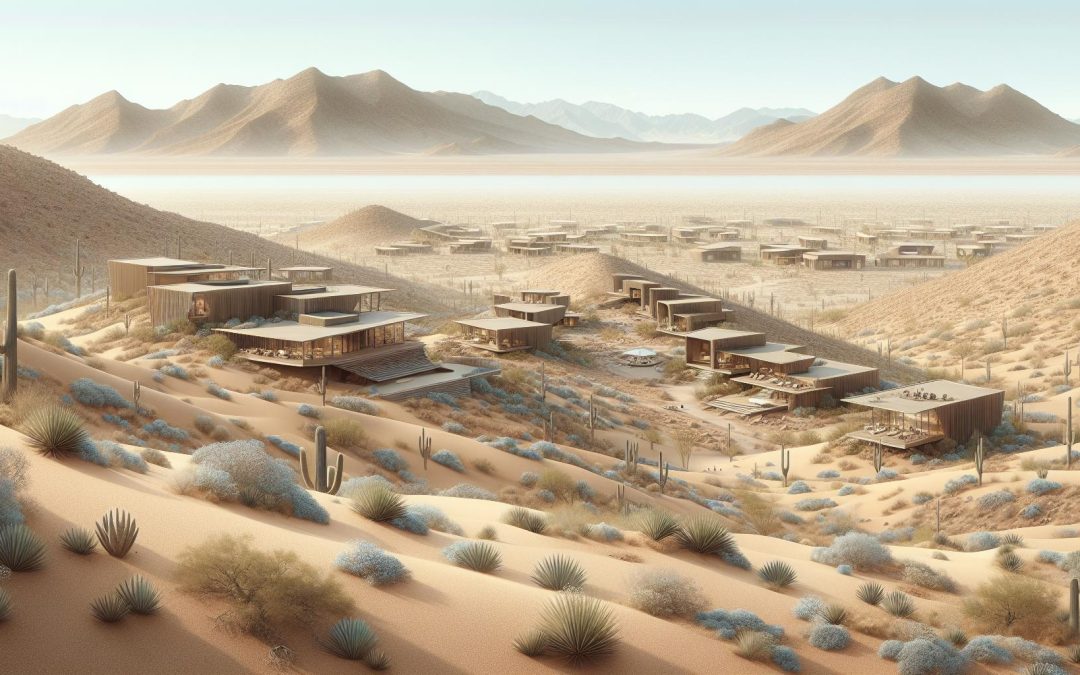Nestled in the desert landscape of Scottsdale, Arizona, stands Taliesin West, a testament to the genius of Frank Lloyd Wright. It’s not just a building; it’s an embodiment of Wright’s philosophy, blending architecture with the natural environment in a way that’s both breathtaking and inspiring.
I’ve always been fascinated by Wright’s work, but visiting Taliesin West was a whole new level of awe. This architectural marvel, built as Wright’s winter home and studio, showcases his innovative designs and the harmonious relationship he envisioned between humanity and its habitat. Let me take you on a journey through the corridors of this masterpiece, where every corner tells a story of creativity and vision.
History of Taliesin West
My journey into understanding Taliesin West began with its fascinating history. Nestled in the desert landscape of Scottsdale, Arizona, it wasn’t just a home but a profound expression of Frank Lloyd Wright’s commitment to creating spaces that harmonize with their environment. Begun in 1937, Taliesin West was Wright’s winter escape from the harsh winters of Wisconsin, where his original home, Taliesin East, was located.
The name “Taliesin” comes from a druid bard in Welsh mythology, meaning “shining brow.” Wright chose this name to reflect his architectural philosophy that a building should perch on the brow of a hill rather than dominate it, seamlessly integrating with the horizon. This guiding principle is evident in every aspect of Taliesin West’s construction. Wright and his apprentices used local materials, like the desert rocks and sand, ensuring the buildings seemed to emerge naturally from the desert floor.
Perhaps what’s most impressive about Taliesin West is how it served as a living laboratory for Wright. It wasn’t just a residence but a place of constant innovation. Wright and his fellows of the Taliesin Fellowship continuously experimented with design and construction techniques, responding to the challenges posed by the desert environment. This adaptability not only highlights his genius but also his dedication to learning and evolving with his surroundings.
Taliesin West’s history is a testament to Wright’s visionary approach to architecture. It wasn’t merely a building project but a lifelong endeavor that encapsulated his beliefs in organic architecture and the importance of creating spaces that exist in harmony with their surroundings. As I delved deeper into its history, I couldn’t help but feel inspired by Wright’s innovative spirit and the enduring legacy of Taliesin West.
Architectural Features

When I first walked through Taliesin West, I was struck by its harmony with the surrounding Sonoran Desert. Frank Lloyd Wright’s mastery in integrating architecture with nature is evident in every aspect of this stunning complex. He meticulously selected local materials, ensuring that the structures seemed to rise naturally from the ground. The main buildings are constructed from desert rocks, stacked inside wooden forms, filled with concrete to stabilize them. This method not only highlights Wright’s ingenuity but also his commitment to organic architecture.
One of the most captivating features I’ve noticed is the use of light. Wright designed the windows, skylights, and doorways to capture the desert’s light in a way that plays with the interior spaces, changing their mood and appearance throughout the day. He believed in what he called “the destruction of the box,” and his designs at Taliesin West embody this philosophy, with spaces opening up to the landscape, blurring the lines between inside and outside.
Taliesin West also served as Wright’s winter home and the campus for his architecture school. This multifunctional aspect mandated a design that accommodated both living and educational facilities. The drafting room, with its expansive north-facing windows, remains a testament to Wright’s thoughtfulness in designing functional spaces that inspire creativity and productivity.
What’s more intriguing is how Taliesin West reflects Wright’s adaptability and willingness to experiment with architectural forms. Even after the initial construction was completed, Wright continued to tweak and alter the site, viewing it as an ever-evolving project. This characteristic showcases his belief in architecture as a living, breathing entity capable of change and growth.
Visiting Taliesin West, it’s clear to me that every detail, from the choice of materials to the orientation of the buildings, was a deliberate effort to create harmony with the desert environment. Wright’s love for natural beauty and his innovative architectural practices are preserved in this architectural masterpiece, making it a fascinating place not just for architecture enthusiasts but for anyone who appreciates the intricacies of design and the natural world.
Integration with the Natural Environment
When I first visited Taliesin West, I was immediately struck by how seamlessly it melds with the surrounding landscape. It’s not just a structure placed on the desert; it feels like a living part of the Sonoran Desert itself. Frank Lloyd Wright’s genius is on full display here, capturing the essence of organic architecture.
One of the most striking features is Wright’s use of local materials. The walls, constructed from desert rocks and minerals, reflect the colors and textures of the Arizona desert. This choice of materials isn’t just about aesthetics; it’s about creating a deep sense of belonging to the landscape. Wright’s skillful integration of these materials into his design ensures that Taliesin West doesn’t dominate the desert but complements it.
Natural light plays a huge role in the connection between the structure and its environment. Wright carefully designed the windows and openings to capture the ephemeral qualities of desert light. As the sun moves across the sky, the interior spaces are transformed by light and shadow, creating a dynamic interaction between indoor and outdoor spaces. This design principle not only conserves energy by maximizing natural light but also blurs the boundaries between the built and natural environments.
Water features, though less expected in a desert setting, evoke a sense of balance and serenity. Wright introduced reflecting pools and fountains, using water as a natural cooler to mitigate the harsh desert heat. These features add a refreshing contrast to the arid surroundings and offer a soothing auditory experience amidst the desert silence.
The care and thoughtfulness Wright put into integrating Taliesin West with its natural surroundings serve as a lasting example of sustainable and respectful architecture. The synergy between building and landscape here isn’t just a marriage of form and function; it’s a profound statement on the importance of honoring and preserving the beauty of our natural world.
Guided Tours and Visitor Experience
Visiting Taliesin West isn’t just about seeing an architectural wonder; it’s about experiencing the legacy of Frank Lloyd Wright firsthand. I’ve found that the guided tours offered here are an invaluable part of understanding and appreciating this masterpiece. Each tour is designed to give visitors insights into Wright’s vision, the history of the structure, and its integration with the surrounding desert.
The variety of tours available means there’s something for everyone, from architecture aficionados to families looking for an educational outing. I’ve personally gone on a few different tours, and each time, I’ve learned something new. The Insights Tour is a popular choice, providing a comprehensive overview of Taliesin West. For those who have a bit more time, the Extended Insights Tour delves deeper, offering access to spaces not included in the shorter tour.
One of the unique aspects of the tours is the focus on storytelling. The guides are incredibly knowledgeable, and they bring the history of Taliesin West to life with stories about Wright, his family, and the students of the Frank Lloyd Wright School of Architecture. It’s these personal anecdotes that really make the visitor experience special.
Another standout feature is the way the tours are timed to showcase the interplay of light and shadow within the building. If you can, I highly recommend booking a tour during the late afternoon when the setting sun casts dramatic shadows across the architecture. It’s an unforgettable sight and a photographer’s dream.
For families or those looking for a more hands-on experience, there are also workshops and educational programs available. These sessions offer a deeper dive into Wright’s design principles and allow participants to engage in activities that reflect his innovative thinking.
Overall, the guided tours at Taliesin West not only enhance one’s appreciation for Frank Lloyd Wright’s architectural genius but also provide a memorable experience that resonates long after the visit.
Legacy of Frank Lloyd Wright

When I think about the legacy left behind by Frank Lloyd Wright, it’s clear that his influence stretches far beyond the walls of any singular building. Taliesin West is no exception. It’s a living embodiment of Wright’s revolutionary ideas in architecture, blending form with function in a way that had never been seen before. Wright’s design principles have not only shaped the aesthetic landscape of American architecture but have also inspired countless architects around the world.
One of the most remarkable aspects of Wright’s legacy is his commitment to organic architecture. This principle is vividly alive at Taliesin West, where the buildings seem to emerge seamlessly from the surrounding desert. Wright’s designs encourage a harmonious relationship between human habitats and the environment, a concept that’s increasingly relevant in today’s world. His work at Taliesin West is a testament to his vision of creating structures that belong to their landscape, rather than imposing upon it.
Moreover, Wright’s influence extends into the realm of education. The architecture school at Taliesin West is a direct manifestation of his educational philosophies, advocating for a hands-on approach to learning. Students not only study design principles but also engage in the physical labor of building, which Wright believed was essential to understanding architecture. This innovative educational model has contributed to shaping the minds of future architects who carry forward Wright’s legacy.
The preservation efforts at Taliesin West further highlight the ongoing impact of Wright’s work. These initiatives ensure that Wright’s architectural masterpieces remain accessible to the public, allowing new generations to experience his visionary designs firsthand. It’s a testament to the enduring significance of Wright’s contributions to the field of architecture and to the cultural heritage of the United States.
Conclusion
Visiting Taliesin West isn’t just a walk through a stunning architectural site; it’s a journey into Frank Lloyd Wright’s profound vision. Experiencing the way the structures melt into the desert landscape firsthand has given me a deeper appreciation for Wright’s genius in blending human creations with nature. And learning about the hands-on education that continues at the architecture school there has been truly inspiring. It’s a testament to Wright’s enduring influence on architecture and education. I’ve come away with a renewed sense of the importance of preserving such masterpieces so that they continue to inspire and educate for generations to come.







